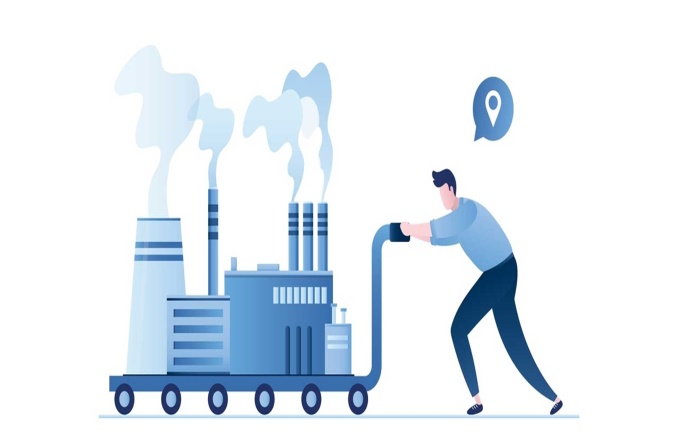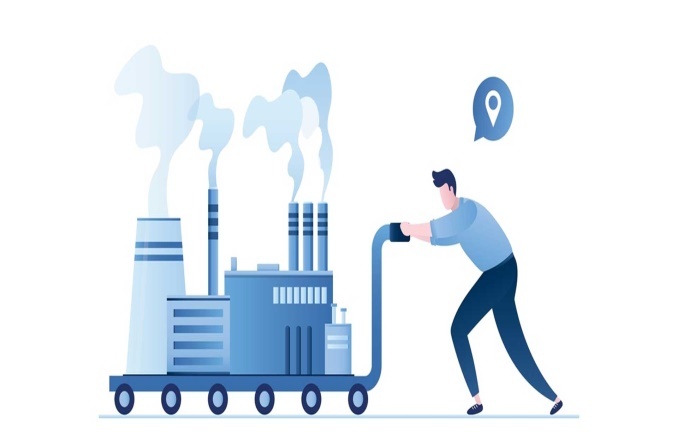Repositioning Production in China: Key Legal Considerations
Last month, the Foreign Legal Affairs Department hosted a seminar on repositioning production in China. This event brought together industry professionals, many of whom had first-hand experience with the relocation process. It was attended by professionals in the manufacturing industry who shared their personal experiences with relocation and emphasized the importance of following the procedures laid out in this article. Discussions centered on the key legal considerations enterprises face when moving their operations. This article highlights the essential aspects of repositioning production in China, including site selection, regulatory compliance, environmental laws, and potential risks.

Why Consider Repositioning Your Production?
Enterprises relocate production in China for a variety of reasons, including:
●Rising land, operating and labor costs
●Access to new markets
●New policy incentives
●Industrial upgrade
●Access to labor
●Regulatory and Environmental Factors
●Government-Mandated Relocation
Types of Relocation and Legal Requirements
There are various types of relocation that Enterprises may undergo, each with specific legal requirements:
●Same-City Relocation
When an enterprise relocates to a new site within the same district, it must update its business certificates with the relevant authorities, such as the State Administration for Market Regulation (SAMR) and the local tax bureau. However, if the move involves a different district, the process becomes more complex. In this case, the enterprise must submit applications to both the current and new district authorities. Key procedures include tax deregistration in the current district, obtaining relocation approvals, and updating the business license in the new district.
●Cross-City Relocation
Enterprises considering cross-city relocation have several options depending on their objectives. Direct relocation involves moving the registered address to another city without altering the company’s legal structure, offering a straightforward approach. Alternatively, enterprises may choose deregistration and new setup, where they close the existing company and establish a new one in the desired city, which may be necessary if legal or operational changes are required. Another option is merger-based relocation, where an enterprise transfers its operations by merging with a company already registered in the new city, allowing for continuity while taking advantage of an established legal presence.
What are the vital considerations?
1. Site Selection: How to Choose the Right Location
Selecting the right location is a crucial step in the relocation process. Here are the main factors to consider:
●Cost of the Site & Utility Costs: Whether you're renting, buying, or building, it’s essential to evaluate both the initial and long-term costs. Factor in property taxes, utility expenses, and potential increases in costs over time. Reliable access to utilities like electricity, water, and gas is equally important frequent interruptions could require backup systems to avoid production disruptions.
●Proximity to Suppliers & Transportation Access: Being close to suppliers can minimize shipping delays and reduce costs, ensuring materials are readily available when needed. Proximity to transportation hubs such as highways, railways, and ports is equally vital for efficient movement of goods.
●Permits, Certifications, and Licenses: Different regions in China have varying regulatory requirements. Understanding the specific permits, certifications, and licenses required for your relocation can help avoid delays during the process.
●Labor Availability & Government Incentives: It’s important to assess the availability of skilled labor in the region and evaluate labor costs to ensure they align with your production needs. Many regions offer government incentives like tax rebates and subsidies, which can provide financial advantages, making the relocation more cost-effective.
2. Environmental Compliance:
Environmental compliance is crucial when relocating production in China. Businesses must first complete an Environmental Impact Assessment (EIA), which requires approval from local authorities before relocation. Compliance with local regulations on resource use and emissions, including energy, water, and waste management, is essential. Companies must also establish Waste Management Systems to handle hazardous materials and ensure they meet local regulations, with regular inspections. Setting up an Environmental Management System (EMS) helps monitor impacts and maintain compliance. Additionally, some industries, like food production or pharmaceuticals, may require special licenses, so securing the necessary certifications beforehand is vital.
3.Labor Compliance:
In China, social security is regionally managed, so when transferring employees to a new city or province, businesses must apply for social insurance transfer-out certificates and wait for the new city to accept the transfer. During this period, it’s crucial to ensure uninterrupted medical coverage. Businesses must also obtain employee consent for relocation. If the transfer is not accepted, economic compensation (severance pay) may be required under PRC law. In some cases, companies will need to terminate existing labor contracts and sign new ones based on the new location.
4.Tax Compliance: Managing Obligations
Tax compliance is a critical part of the relocation process. First, businesses must deregister with the old tax bureau, which includes returning unused invoices and completing any necessary tax filings. After the move, they must register with the new tax bureau to ensure compliance with local tax laws, updating their business information and tax filings accordingly. Additionally, conducting internal tax reviews is essential to identify any potential liabilities and ensure the company is fully compliant with local tax regulations.
Possible Risks to Consider
When relocating production, Enterprises should be aware of the potential risks involved:
●Breach of Contracts: Moving may impact labor or supplier contracts, requiring renegotiation or termination.
●Failure to Obtain Relocation Approvals: Without proper approvals from local authorities, businesses may face fines or forced shutdowns.
●Invalidation of Land Use or Licensing: Verify land use rights and business licenses before moving to avoid complications.
●Labor Disputes: Clear communication with employees is essential to avoid disputes during the relocation process.
●Tax and Environmental Compliance Issues: Failing to follow proper tax deregistration and environmental procedures can result in fines or legal issues.
Key Takeaways
Successfully relocating production in China requires thorough preparation and attention to detail. Ensure all required notifications and filings are submitted on time to avoid delays. Conduct a thorough legal review of potential risks, communicate with clients, partners, and employees early to prevent contract issues, and update your business registration with the relevant authorities. Make sure environmental permits are renewed or obtained as needed, and manage the reassignment of employees to minimize labor disputes. Protect your intellectual property rights and maintain accurate documentation of business assets. Taking these steps will help ensure a smooth and legally compliant relocation.
在中国变更生产地址的主要法律考虑
上个月,广悦涉外法律服务领域主办了一场关于外资企业在中国变更生产地址的研讨会。此次活动汇集了业内专业人士,其中许多人都有变更生产地址的第一手经验。参加研讨会的制造业专业人士分享了他们在变更生产地址中的亲身经历,并强调了遵循本文所述程序的重要性。讨论围绕企业在搬迁时面临的主要法律问题展开。本文重点介绍了在中国变更生产地址的重要方面,包括选址、合规性、环境法和潜在风险。

为什么要考虑变更生产地址?
企业将生产迁往中国有多种原因,其中包括:
●土地、运营和劳动力成本上升
●进入新市场
●新的政策激励
●产业升级
●获得劳动力
●法规和环境因素
●政府强制搬迁
搬迁类型和法律要求
企业可能进行的搬迁有多种类型,每种类型都有具体的法律要求:
●同城搬迁
当企业搬迁到同一区内的新址时,必须向国家市场监督管理总局(SAMR)和地方税务局等相关部门更新营业执照。但是,如果搬迁到不同的地区,程序就会变得更加复杂。在这种情况下,企业必须同时向当前和新的地区当局提交申请。主要程序包括在当前地区注销税务登记、获得搬迁批准以及在新地区更新营业执照。
●跨市搬迁
考虑跨市搬迁的企业可根据其目标选择多种方案。直接搬迁是指在不改变公司法律结构的情况下,将注册地址迁移到另一个城市,这是一种简单直接的方法。另外,企业也可以选择注销注册和新设公司,即关闭现有公司,在所需城市设立新公司。另一种选择是合并搬迁,企业通过与已在新城市注册的公司合并来转移业务,这样既能保持连续性,又能利用已有的法律存在。
有哪些重要的考虑因素?
1. 选址: 选择合适的地点
选择合适的地点是搬迁过程中至关重要的一步。以下是需要考虑的主要因素:
●场地成本和公用事业成本: 无论您是租房、买房还是建房,都必须评估初始成本和长期成本。将房产税、公用事业费用以及随着时间推移可能增加的费用考虑在内。可靠的电力、水和煤气等公用设施同样重要,经常中断可能需要备用系统,以避免生产中断。
●靠近供应商和交通便利: 靠近供应商可以最大限度地减少运输延误并降低成本,确保在需要时随时可以获得材料。靠近公路、铁路和港口等交通枢纽对于货物的高效运输同样至关重要。
●许可证、认证和执照: 中国不同地区有不同的监管要求。了解搬迁所需的具体许可、认证和执照有助于避免搬迁过程中的延误。
●劳动力可用性和政府激励措施: 重要的是要评估该地区熟练劳动力的可用性,并对劳动力成本进行评估,以确保其符合您的生产需求。许多地区的政府提供退税和补贴等激励措施,这可以提供经济优势,使搬迁更具成本效益。
2. 环境合规性:
在中国进行变更生产地址时,环境合规性至关重要。企业必须首先完成环境影响评估(EIA),并在搬迁前获得当地政府的批准。必须遵守当地的资源使用和排放法规,包括能源、水和废物管理。公司还必须建立废物管理系统来处理有害物质,并确保其符合当地法规,同时定期进行检查。建立环境管理系统(EMS)有助于监测影响并保持合规。此外,某些行业(如食品生产或制药)可能需要特殊许可证,因此事先获得必要的认证至关重要。
3. 劳动合规:
在中国,社会保险实行属地管理,因此企业在将员工调往新的省市时,必须申请社会保险转出证明,并等待新的省市受理。在此期间,确保医疗保险不中断至关重要。企业搬迁还必须征得员工同意。如果调职不被接受,根据中国法律,可能需要支付经济补偿金(遣散费)。在某些情况下,企业需要终止现有的劳动合同,并根据新的工作地点签订新的劳动合同。
4. 税务合规: 管理义务
税务合规是搬迁过程中的一个关键部分。首先,企业必须在原税务局注销登记,包括退还未使用的发票和完成必要的税务申报。搬迁后,企业必须在新税务局注册,以确保遵守当地税法,并相应更新企业信息和税务申报。此外,进行内部税务审查对于确定任何潜在债务和确保公司完全符合当地税收法规至关重要。
应考虑的可能风险
在变更生产地址时,企业应了解其中涉及的潜在风险:
●违反合同: 搬迁可能会影响劳动合同或供应商合同,需要重新谈判或终止合同。
●未获得搬迁批准: 如果没有当地政府的适当批准,企业可能面临罚款或被迫停产。
●土地使用权或许可证失效: 在搬迁前核实土地使用权和营业执照,以避免问题复杂化。
●劳资纠纷: 在搬迁过程中,与员工进行清晰的沟通对于避免纠纷至关重要。
●税务和环境合规问题: 不遵守正确的税务注销登记和环保程序可能会导致罚款或法律问题。
主要启示
在中国成功变更生产地址需要充分的准备和对细节的关注。确保按时提交所有必要的通知和文件,以避免延误。对潜在风险进行全面的法律审查,及早与客户、合作伙伴和员工沟通,防止出现合同问题,并在相关部门更新企业注册信息。确保根据需要更新或获得环境许可证,管理好员工的重新分配,尽量减少劳资纠纷。保护您的知识产权,保存准确的企业资产文件。采取这些步骤将有助于确保顺利、合法地完成变更生产地址。
声明
本文仅为交流探讨之目的,不代表广悦律师事务所或其律师出具的任何形式之法律意见或建议。如需转载或引用本文的任何内容,请与本所沟通授权事宜,并于转载或引用时注明出处。如您有意就相关议题进一步交流或探讨,欢迎与本所联系。
本期作者


涉外法律服务领域介绍
涉外法律服务领域是由高级合伙人王敬律师及其他合伙人组建成立并领导的。该领域汇聚了中国、中国香港、中国澳门、美国、英国、德国、BVI等国家与地区的执业律师、高级顾问、项目经理等经验丰富的法律服务人员,擅长处理跨境交易及争议解决等复杂法律事项,在金融及投资并购、国际贸易及信用证、跨境投资、海事海商、保险、公司法律服务、外商直接投资、知识产权、商标服务、劳动争议以及其他一般商业纠纷案件(诉讼及仲裁)等方面具有丰富的办案经验和卓越的成就,团队客户主要包括大型国企、外国企业、船东互保协会、保险公司、航运公司、国际银行及金融机构等。
作者丨Franco Fornari、Karen Chipita
编辑丨苏韵
审核丨黄晓俊
审定丨品牌宣传与市场拓展委




